7.1 Basic software concepts
|
Previous
Chapter 6: Extended hardware concepts
|
Next
Chapter 8: Extended software concepts
|
 CHAPTER OVERVIEW
CHAPTER OVERVIEW
 At the end of this chapter, you should be able to:
At the end of this chapter, you should be able to:
- Describe what software is.
- Describe the types of software.
- Describe the differences, advantages and disadvantages of each type of software.
- Describe what an operating system is and give examples thereof.
- Describe what GUI is and give examples of some of the elements.
- Explain basic PC security.
INTRODUCTION
In Chapter 1, you learned that software is a set of programs or instructions that tells the computer and its hardware how to perform specific tasks. Without software, most computers would be useless, for example without Microsoft Word software it will be difficult to type out assignments and use specialised fonts and WordArt.
In this chapter, we will look at the basic software concepts, different software components and different types of software.

Something to know
The term “software” was not used until the late 1950s. In 1948, computer scientist, Tom Kilburn, was responsible for writing the world’s first piece of software. Kilburn and one of his colleagues created one of the earliest computers, which was called the Manchester Small-Scale Experimental Machine (SSEM), also known as the “Baby”. The SSEM used coded instructions programmed into it to do mathematical calculations. This piece of software took 52 minutes to correctly calculate 218, which is 262.144.
UNIT
7.1 Basic software concepts
In this unit, we will look at the different concepts used in software. To begin, however, we will look at the different types of software.
Software consists of the following two categories, which will be explained in detail later on:
1.Application software: Application software allows you to perform tasks, such as playing games, creating slide show presentations, creating spreadsheets, and so on. There are many different types of application software programs.
2.System software: This includes the operating system and other software that controls and manages the operation of the computer.

WHAT IS SOFTWARE?
APPLICATION SOFTWARE
Whether it is creating a report for work, typing out an assignment for school, messaging a friend, or just trying to find out where you can buy the latest PlayStation, there is probably an application (app) that can help you find what you are looking for. Unfortunately, there is no application that explains what it is, or what it does. So, in this section we will look at this term and how it has developed – and you do not even need an application to read it!
As you have learned, computer software is a set of instructions that tells a computer what to do and how to do it. Although the computer cannot run without system software, application software is the most useful type for computer users, as it helps us perform many of the tasks that make us use computers in the first place, such as web browsing, word processing and spreadsheet processing.
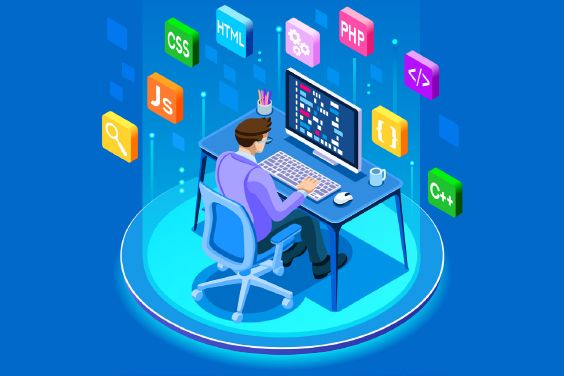
Over recent years, classifying applications according to computing platforms has become more difficult. A platform is the combination of hardware and software required to make an application run. In the past, the type of software running on a computer depended on the operating system, for example, some software works with a Windows operating system; other software only works with an iOS or Unix system. That has changed, however; new development in software has resulted in many applications no longer relying on a specific operating system, it runs on the web and can be accessed through a browser.
TYPES OF APPLICATION SOFTWARE
The table below shows some of the different types of application software installed on a computer. You should note that although software is identified as a program, it can be anything that runs on a computer.

Something to know
In a few years’ time, application software will develop even more. According to software developers, we are likely to see less emphasis on desktop PC software and an increased emphasis on cloud and mobile applications. Although this may benefit users in terms of user-friendliness, it can lead to potential privacy and security risks.
Table 7.1: Examples and types of application software
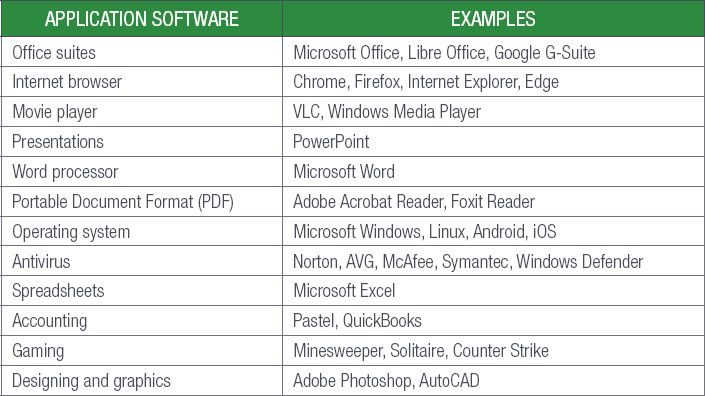
Some application software, such as Wordpad, Notepad, Calculator, Paint and the Snipping Tool, all come packaged with the system software of the Microsoft Windows operating system. We will briefly look at these basic programs and how they can be useful to you.
ACCESSORIES
Microsoft Windows includes a few programs, such as the Calculator, Paint and Snipping Tool. You can start any accessory from the Start menu. An accessory is any device or program that is not necessarily required, but it can be added to a computer to perform an additional function.

Something to know
You can access these programs by clicking on the Start menu and searching for the program.
WINDOWS CALCULATOR
To use the Windows Calculator accessory you can do the following activities:
 Guided Activity 7.1
Guided Activity 7.1
1.Click the Start button.
2.Type in calc.
3.Click Calculator from the search results.
The calculator will appear on your desktop.
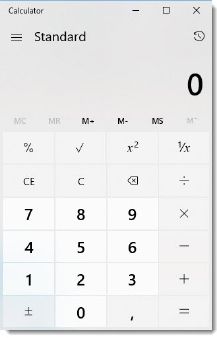
 Guided Activity 7.2
Guided Activity 7.2
To perform a simple calculation, you can do the following:
1.Use the keyboard to type in the required data.
2.Or, you can type in the data by using the mouse and clicking on the buttons of the calculator.
3.Press the Enter key to get your answer.

Something to know
Did you know that you can change the type of calculator from standard to scientific, or to a programming calculator by clicking on the icon  on the left-hand side of the calculator. So, next time you have some homework that requires a calculator, maybe this program could be of some use.
on the left-hand side of the calculator. So, next time you have some homework that requires a calculator, maybe this program could be of some use.
SNIPPING TOOL
This tool captures all, or part of the computer screen as an image. You can save this image, attach it to an email, or even paste it into another application, such as Microsoft Word or Microsoft Paint.
 Guided Activity 7.3
Guided Activity 7.3
To access this program, you can do the following:
1.Click on the Start menu.
2.Type in snip.
3.Click on the Snipping Tool from the search results.
To capture a snip, you can do the following:
4.In the Snipping Tool, select Mode. You can choose any of the following types of snips:
- Free-form snip
- Rectangular snip
- Window snip
- Rectangular snip

USING THE SNIPPING TOOL
You can learn how to snip the computer screen by opening the QR code shown below.

5.Select the area that you want to snip.
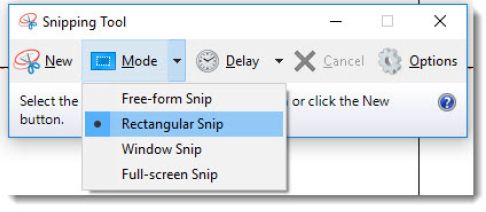
6.After you have captured your snip, save the snip.
7.This is done by clicking on File > Save As.
8.Type a file name and then click on Save.
PAINT
Microsoft Paint is an accessory that provides virtual pens and brushes to create art or even text.
 Guided Activity 7.4
Guided Activity 7.4
To use this program, you can do the following:
1.Click on the Start button.
2.Type in paint.
3.Click Paint in the search results.
The Paint window will then open and you can create your own canvas by clicking or dragging the mouse, or by using the brushes.
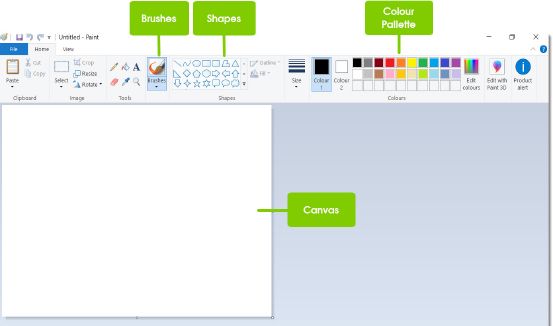
SYSTEM SOFTWARE
System software is the specific type of software that manages the computer. Much like a traffic officer at a busy intersection, the system software manages the flow of data and information in the computer. This is done in the following ways:
- Translating the instructions from the software to a language that the hardware can understand
- Sending these instructions to the correct hardware
- Receiving information from the hardware (such as, the button press on a keyboard) and sending it to the software
- Allowing different applications to speak to each other
- Making sure all the hardware and software on the computer are in a good condition
The operating system (OS) is the most important type of system software as it manages all the other programs in the computer.
TYPES OF SYSTEM SOFTWARE
The table below shows some of the different types of system software installed on a computer.
Table 7.2: Examples and types of system software
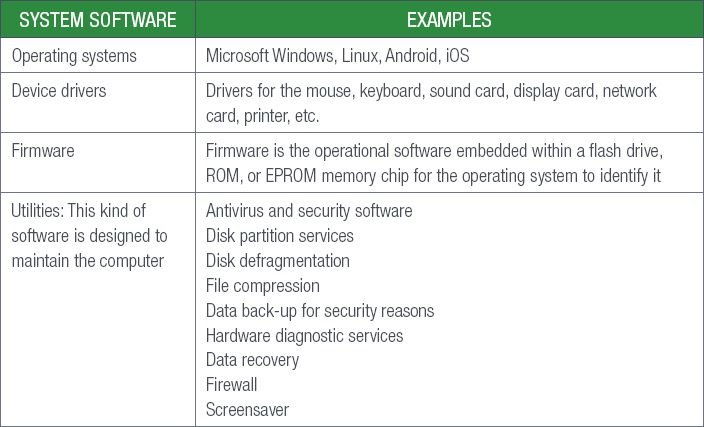
 Activity 7.1
Activity 7.1
1.What is a platform?
2.Match the following software in Column A with the correct example in Column B:

UNIT
7.2 Operating system
When you turn on a computer, it is nice to be able to move the mouse, play music, or even browse the web with just a click. However, as easy as it looks, there is a lot going on inside the computer and the real mastermind behind handling all the necessary tasks, is the operating system. Most desktops or PCs come preloaded with Microsoft Windows while Macs are preloaded with Mac OS X. Other PCs and desktops may use the Linux or UNIX operating systems.

Take note
Before everything else, the operating system is the first thing loaded onto the computer. Without the operating system, a computer is pretty useless.
Recently, operating systems are found in smaller computers and devices that we use every day; from smartphones to wireless access points. The purpose of an operating system is to organise and control both the hardware and software to perform specific tasks.
Any device that has an operating system allows you to change how the device works. This means that you can add a new security update, a new application, or even install a new operating system (depending on compatibility) whenever you want to. So, no need to throw your computer away each time you need to add a new application or update! As long as you understand how an operating system works, you can change some of the ways in which it operates; the same applies for your phone.
What exactly can an operating system do? In the following section, we will take a brief look at the role that the operating system plays.

UNDERSTANDING THE OPERATING SYSTEM
THE ROLE OF THE OPERATING SYSTEM
The operating system of a computer manages all the software and hardware of the computer. In other words, the operating system has many different functions and jobs. In most cases, people generally have a number of programs running at the same time on their computers. These programs all need to access the computer’s CPU, storage and memory. The operating system manages and coordinates these processes so that the program gets what it needs to run.
THE OPERATING SYSTEM AND GUI
Operating systems are usually preloaded onto any computer you buy. Most users use the operating system that comes with their computers; however, this can be updated or even changed when required. The most popular operating systems for PCs are Microsoft Windows, Mac OS X and Linux.
Modern operating systems use a graphical user interface (GUI). This interface allows you to use the mouse to click on buttons and the keyboard to type text; while everything is shown clearly on the display screen as graphics and text.
Each operating system has a different look; so, if you decide to change operating systems at some point, it might initially feel weird and unfamiliar. However, modern operating systems are designed to be easy to use and the basic operating principles are the same.
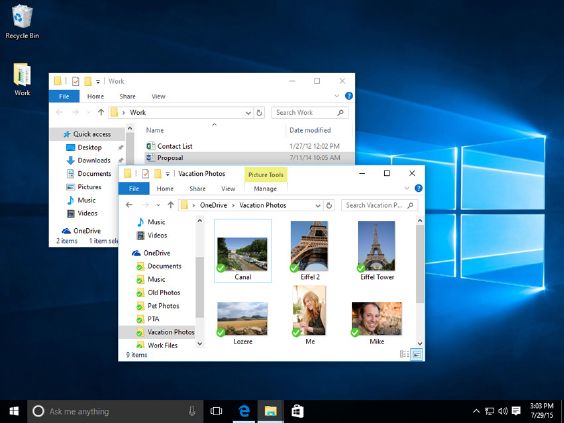
TYPICAL FEATURES OF A GUI
A GUI uses windows, icons and menus to perform commands, such as opening, moving, closing and deleting files. Although most GUI systems use the mouse to navigate, it can also use hotkeys and arrow keys.
GUI elements are included, but not limited to the following:
- Input controls: Checkboxes, option buttons, list boxes and dialogue boxes
- Navigational components: Icons, menu usage and navigation
- Informational components: Toolbars and message boxes
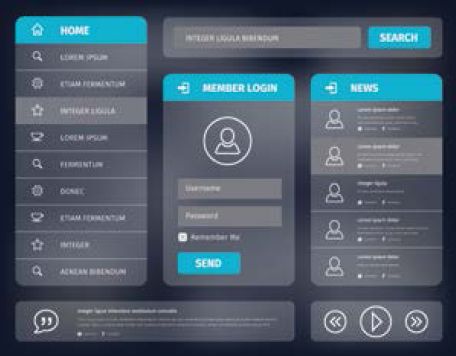
These operating system elements are grouped in tables and are briefly discussed below.
Table 7.3: Input controls
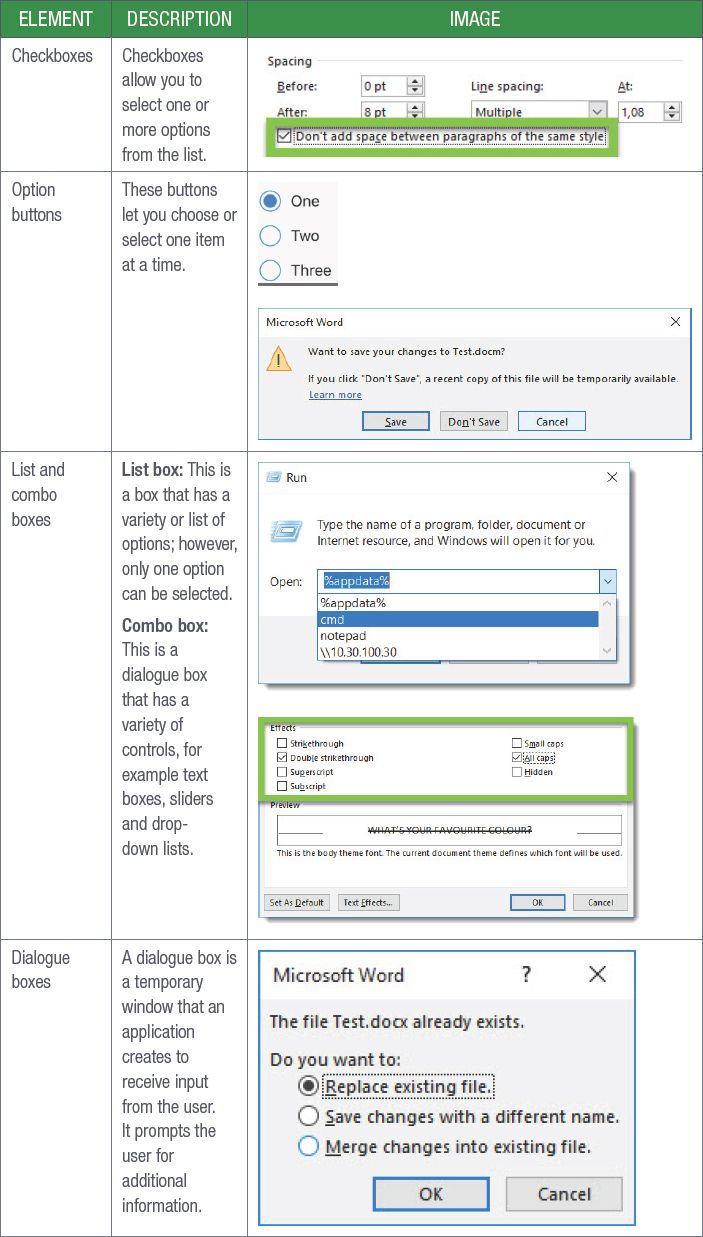
Table 7.4: Navigational components
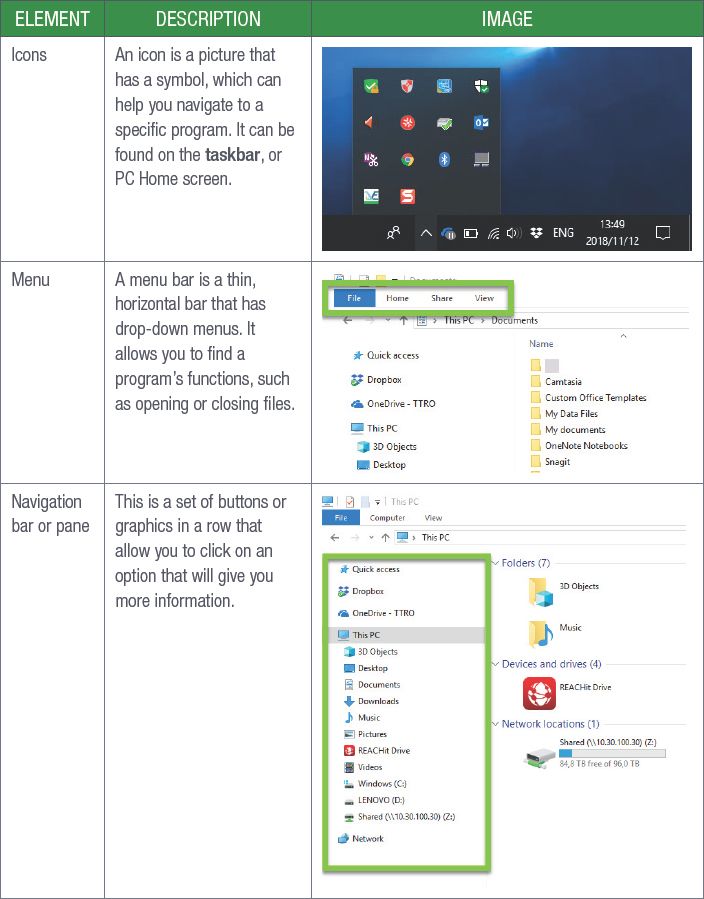
Table 7.5: Informational components
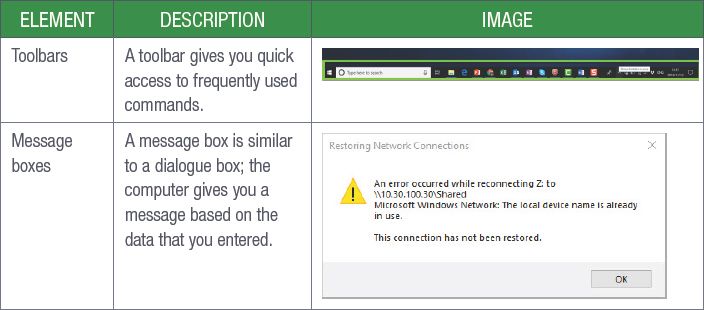
DIFFERENT OPERATING SYSTEMS
The three popular operating systems for PCs are:
1.Microsoft Windows
2.Mac OS X
3.Linux
MICROSOFT WINDOWS
Microsoft Windows is one of the most popular operating system. Microsoft is calling Windows 10 “the last version of Windows”. This is not because it is killing off Windows, but because it decided to rather keep improving and updating Windows 10.

MAC OS X
This is a range of computer systems created by Apple. All Macintosh computers, better known as Macs, come preloaded with this operating system. All their recent versions are known as OS X with, the latest version that was released in 2018, called Mojave.
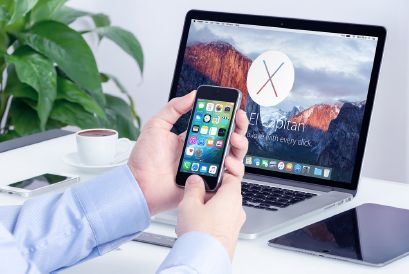

Something to know
According to StatCounter Global Stats, there are only about 10% Mac OS X users of global operating systems, which is really low compared to Windows users (about 80%). A reason for this is that Apple computers tend to be much more expensive; although most people prefer the look and feel of Mac OS X over Windows.
The iPhone and iPad both have the iOS 9 user interface.
LINUX
Linux is a group of open-source operating systems. This means that it can be modified and distributed across the world by anyone. The advantages of Linux are that it is free and there are many different versions from which you can choose, for example, Linux Mint, Ubuntu, CentOS 7, etc.
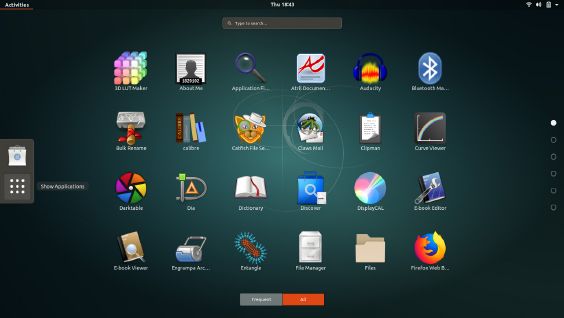

Something to know
According to StatCounter Global Stats, Linux users are less than 2% of global operating systems. Most servers run on Linux, which makes it easier to customise.
MOBILE OPERATING SYSTEMS
All of the previously mentioned information on operating systems is pretty much designed to only run on desktops or laptops. Mobile devices, such as phones, tablets and iPads differ from PCs or laptops and, therefore, have different operating systems designed just for them. Examples of these systems are Google Android, Apple iOS, Nokia Symbian, BlackBerry OS, etc.
Most mobile operating systems are tied to specific hardware, with little flexibility. It also does not have as many features as the operating systems of PCs and laptops, and the different devices cannot all run on the same software.
Mobile devices with communication abilities, for example smartphones, have the following two operating systems: the main user-facing software platform and a second lower-level proprietary real-time operating system, which operates the radio and other hardware.
A mobile operating system starts when the device is powered on, presenting a screen with various icons or tiles that provide specific information and application access. It also manages cellular and wireless network connectivity, as well as phone access.
 Activity 7.2
Activity 7.2
Are the following three statements true or false? If false, provide the correct answer.
1.The operating system is a type of hardware.
2.Modern operating systems use a graphical user interface (GUI).
3.A menu bar gives you quick access to frequently used commands.
4.Which one of the following systems is an open-source operating system?
a.Linux
b.Windows
c.Mac OS
5.Look at the diagram below and answer the questions that follow.
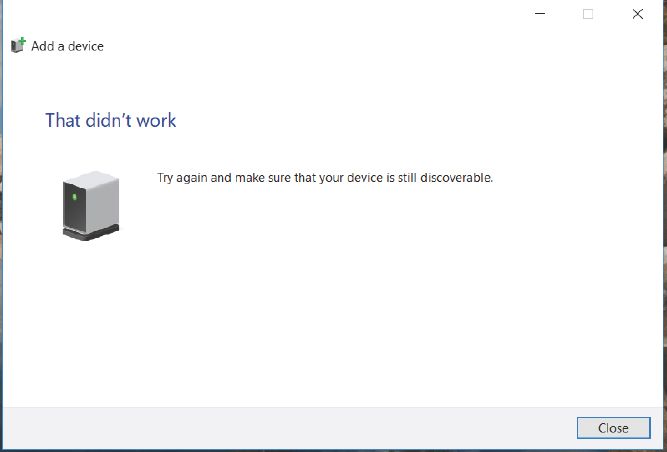
a.What type of GUI element is shown in this diagram?
b.Explain the type of element shown. Give a brief description of this element.
c.The diagram shows that the user was trying to connect to a peripheral device. Is this statement true? Motivate your answer.
d.According to the diagram, what method of connection is being used (this will be based on your answer in question c above)?
UNIT
7.3 Being more secure
Computer security is something every computer user should take very seriously. A breach in security can cause major problems. This means that you must do certain things to prevent and detect unauthorised access to your computer. Unauthorised use refers to anyone that gets access to your computer without your permission. In the worst-case scenario, this can refer to hackers who break into computer systems to steal, change or destroy information.
One of the steps you can take to be more secure, is to create a password that allows access to your computer.
CREATE A PASSWORD
Computer passwords are used to help identify the correct user and also prevent unauthorised use. A password consists of a string of secret characters, numbers, or words that are used to verify the identity of a user during the authentication process. It is used together with a username, and is designed to be known only to the user and allow that user to gain access to a device, application or website.
You can create a password in Windows 10 by doing the following:
1.Click on the Start button.
2.Type in Control Panel.
3.Open the Control Panel, and click on User Accounts.
4.Open User Accounts and choose Make changes to accounts.
5.Click on Add a new user in PC settings.
6.Choose Make changes to my account in PC settings.
7.Click or tap Sign-in options from the left.
8.In the Password area, click on the Add button.
9.Enter the new password correctly in both text fields, where required.
10.In the Password Hint field, enter something that will help you remember the password. Click Next.
11.Click on Finish to complete the password setup.
To access your computer, you need to key in the correct login name and password. You must ensure to log off when you are done with your computer so that no one else has access to your information.
TIPS FOR CREATING A PASSWORD
- The longer the better – a minimum of 12-characters is recommended.
- Mix it up; use variations on capitalisation, spelling, numbers and punctuation.
- Avoid names, places and dictionary words.
- Use a sentence that you will remember, for example, your name and date of birth.
- Use the first letters of each word as your password, for example, “My name is Julia Mabula and I was born on 13 March 2001!” The password would then be “MniJMaIwbo13M21!” – it consists of 16 characters: letters – upper- and lowercase, numbers and symbols.

CAN’T REMEMBER MY PASSWORD
Should you forget your password, click on this QR code to find out how you can reset it:

https://www.techrepublic.com/article/how-to-reset-your-windows-10-password-when-you-forget-it/
OTHER AUTHENTICATION METHODS
The world of computers is changing every year. Nowadays, with the touch of your finger, you can unlock your computer and phone. Businesses that are really serious about their security use fingerprint scanning, facial recognition, or an iris scanner to protect the information on their computers.
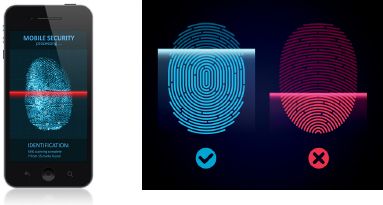
SCREEN LOCK PATTERN
Users can secure their smartphones or tablets by using a screen lock. So, every time the user turns the phone on, or wakes it up from standby mode, it requires a screen lock pattern. This can be in the form of a pin, password, fingerprint scan and nowadays, users can unlock their devices by scanning their retina.
More about the pattern:
- It is a simple pattern that is drawn with the user’s finger.
- It makes the device more secure and less accessible by others.
- If you take privacy very seriously, using a pattern to lock the device can actually be handy.
 Activity 7.3
Activity 7.3
Read the following scenario and answer the questions that follow:
The Mo-ho family used a desktop computer connected to a printer, keyboard and wireless mouse at home for some time. Mrs Mo-ho has now started her own catering business, which she runs from home and requires that she interact with foreign clients.
1.List one essential output device, other than a printer, that she will need to perform her duties.
2.List one essential input device, other than a keyboard and mouse, that she will need to perform her duties.
3.Mrs Mo-ho stores sensitive sales information on her computer. She uses a login ID, with her numeric birth date (2907) as the password to access her computer. However, she is scared that someone might crack her password and gain access to her computer.
a.State two ways in which she could strengthen her password.
b.List one example of an authentication device, which could be used as part of her computer system to gain access to her computer, as well as give her an extra layer of security.
REVISION ACTIVITY
1.Explain briefly what is meant by the term “software”. (2)
2.The image below shows a box that you will often use when formatting paragraphs in the Microsoft Word processor.

Write down the letter of the label that matches each of the following components:
a.Dialogue box
b.Close button
c.Option button
d.Check box
e.Combo box (5)
3.What do the letters GUI stand for? (1)
4.What is the function of a GUI? (2)
5.Johan often uses Microsoft Paint, the Calculator application and the Snipping Tool to assist him with homework tasks. Which of the applications would he most likely use to do the following:
a.Resize a photograph taken with his smartphone camera
b.Take a screen capture of an image found on a website for a project
c.Convert a temperature in degrees Farenheit to degrees Celcius. (3)
6.Explain the difference between application software and system software. (4)
7.Match the number of the application software type in Column A with the letter of the example in Column B.
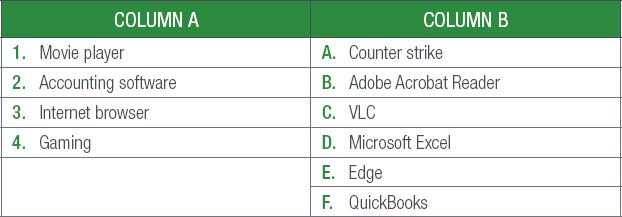
(4)
8.Mention two functions of an operating system. (2)
9.Give the name of an operating system that is used for smartphones. (1)
10.Rate each of the following passwords as “weak”, “strong” or “very strong”:
a.N@t1onal2o19
b.Long2Montagu#Electric)Lego
c.SamHolly (your dogs’ names) (3)
11.Mention two types of access control systems that are found on smartphones other than a password or pin. (2)
TOTAL: [29]
AT THE END OF THE CHAPTER
Use the checklist to make sure that you worked through the following and that you understand it
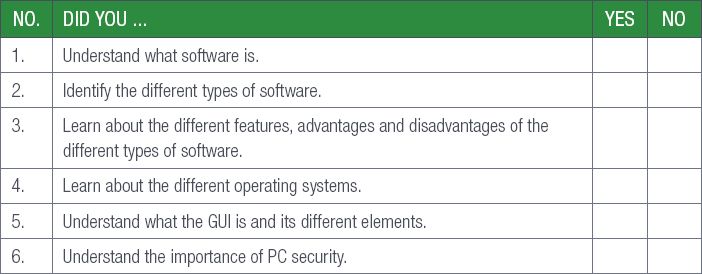
|
Previous
Chapter 6: Extended hardware concepts
|
Table of Contents |
Next
Chapter 8: Extended software concepts
|



